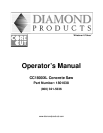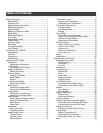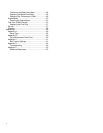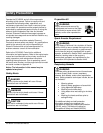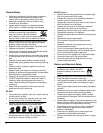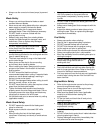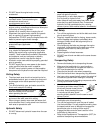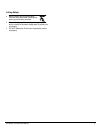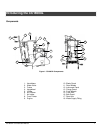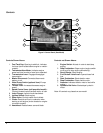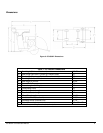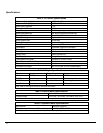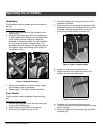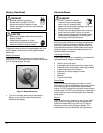
CC1800XL Concrete Saw Manual 3
• Always use the correct size fuses (amps) to prevent
fires.
Blade Safety
• Always use reinforced abrasive blades or steel-
centered diamond blades.
• Never use a wet cutting blade without an adequate
water supply to properly lubricate the blade.
• Inspect all blades prior to usage and discard
damaged blades. Clean dirty blades as necessary.
• DO NOT install or remove a blade with the
engine/motor running.
• Keep all body parts away from rotating blades.
• Inspect the blade flanges for damages, wear, and
cleanliness. Clean or replace dirty/damaged
components immediately.
• DO NOT expose yourself or anyone else
to the direct line of the blade when
operating the saw.
• Always use an appropriate size blade and the
correct blade type based on the cutting task and the
type of material being cut.
• The blade must always fit snug on the blade shaft
and/or outer flange.
• Wear gloves and be alert to the surrounding
environment when handling blades.
• When installing the blade, always point the arrow
printed on the blade in the direction of the blade
shaft’s rotation.
• DO NOT exceed the blade’s maximum
recommended speed when cutting. Excessive blade
speeds can cause blade breakage, resulting in
serious injuries and/or death!
• DO NOT use damaged blades when cutting to avoid
harming yourself, others, or the saw.
• DO NOT use a blade for cutting that requires a lower
speed than the blade shaft speed.
• Tighten the blade shaft screw/nut as directed to
properly secure the outer flange and blade. Failure
to properly secure the outer flange and blade may
cause parts to loosen or fall off the saw.
• Let the blade cool prior to removal when dry cutting
(applicable models).
Blade Guard Safety
• DO NOT operate the saw with the blade guard
raised or removed.
• Blade exposure should not exceed 180° while
cutting.
• When pivoting the front of the blade guard,
raise/lower it cautiously and slowly to avoid serious
injuries.
• Always pivot the front of the blade guard
180° (fully upward) so the guard does not
swing down unexpectedly, causing serious
injuries.
• DO NOT install or remove the blade guard with the
engine/motor running.
• Always use a blade guard that corresponds with the
blade size.
• Inspect the blade guard and water tubes prior to
starting the saw. Clean or replace dirty/damaged
components immediately.
Fuel Safety
• Always use caution when refueling.
• Store all fuel in appropriate safety containers.
• DO NOT operate the saw with a fuel leak.
• DO NOT fuel the saw with the engine running.
• Let the engine cool prior to adding fuel.
• Refer to the engine manual for recommended fuels.
• Always use appropriate fuels in cold weather.
• Move the saw away from the refueling area prior to
starting the engine.
• DO NOT smoke or expose fuel to open
flames when filling the fuel tank or
working with fuel.
• Clean up any spilled fuel prior to starting the engine.
• Drain the fuel tank and fuel lines when storing the
saw for longer periods of time. Refer to the engine
manual for additional recommendations.
• Fuel may seep out from the fuel cap vent (applicable
models) when raising the saw if the fuel tank has
been overfilled.
Engine/Motor Safety
• Refer to the engine/motor manual as the primary
source for engine/motor safety.
• Always know how to turn off the engine/motor
quickly for emergency purposes.
• Make sure the speed control lever (applicable
models) is at Neutral when starting the
engine/motor.
• Fill the fuel tank and check the oil level prior to
starting the engine.
• Keep all body parts away from
rotating saw parts with the
engine/motor running.
• DO NOT start the engine without the air filter(s)
installed.
• DO NOT allow dust to enter the air intake tube when
cleaning/replacing air filter(s).
• Replace damaged components immediately that
may allow dust to enter the engine.



